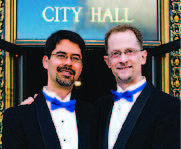 As the new year commences, we initiate a new name for our column: 6/26 and Beyond. You might ask: What’s 6/26? It’s June 26–not only the date of the founding of the United Nations (1945), and for that matter the invention of the toothbrush (1498)–but the date the United States Supreme Court issued its three most important landmark LGBT rights decisions. Indeed, Congresswoman Suzan DelBene, along with 93 cosponsors, has introduced legislation that would designate June 26 as national “LGBT Equality Day.”
As the new year commences, we initiate a new name for our column: 6/26 and Beyond. You might ask: What’s 6/26? It’s June 26–not only the date of the founding of the United Nations (1945), and for that matter the invention of the toothbrush (1498)–but the date the United States Supreme Court issued its three most important landmark LGBT rights decisions. Indeed, Congresswoman Suzan DelBene, along with 93 cosponsors, has introduced legislation that would designate June 26 as national “LGBT Equality Day.”
Twelve years ago, on June 26, 2003, the U.S. Supreme Court issued its breakthrough decision, Lawrence v. Texas, finally holding that laws criminalizing the physical expression of love and affection between people of the same gender violate the Constitution. In the Court’s own eloquent words: “At the heart of liberty is the right to define one’s own concept of existence, of meaning, of the universe, and of the mystery of human life.” The government “cannot demean” the “existence” of LGBT people or “control their destiny by making their private sexual conduct a crime.” For the first time in American history, the Court recognized LGBT love, describing how “intimate conduct” between people of the same sex “can be but one element in a personal bond that is more enduring.”
Ten years after Lawrence–on June 26, 2013–the Court expressed a deeper understanding of LGBT love and dignity in its landmark United States v. Windsor decision, overturning key elements of the so-called Defense of Marriage Act (“DOMA”) that prohibited the federal government from recognizing same-sex couples’ marriages. In Windsor, the Court recognized that marriage equality states like New York had enabled LGBT couples to “live with pride in themselves and their union and in a status of equality with all other married persons” but that DOMA served to “injure” and “disparage” these couples and to make them “unequal” to everyone else. Reflecting a profound understanding of the daily human cost of such discrimination, the Court noted that “DOMA instruct[ed] all federal officials, and indeed all persons with whom same-sex couples interact, including their own children, that their marriage [was] less worthy than the marriages of others.”
And last summer–June 26, 2015–the Court held in Obergefell v. Hodges that the liberty and equality guarantees of the Constitution mandate nationwide marriage equality. The Court’s opinion evinced great understanding of the struggles, hopes and dreams of LGBTQ Americans. The decision recounted how throughout much of our nation’s history “[g]ays and lesbians were prohibited from most government employment, barred from military service, excluded under immigration laws, targeted by police, and burdened in their rights to associate.” The Court recognized our struggle from protest to political involvement to legal action. And it acknowledged the inadequacies of partial victories: “Outlaw to outcast may be a step forward, but it does not achieve the full promise of liberty.” The Court named marriage discrimination for what it was: “injustice.” And it concluded that by seeking marriage equality, LGBTQ people “ask for equal dignity in the eyes of the law. The Constitution grants them that right.”
That’s what 6/26 has meant so far for LGBT equality. But the new title of our column is “6/26 and Beyond.” What does “beyond” mean? One thing it means is that the marriage equality victories represent extraordinarily important advances toward a broader goal: full LGBTQ equality in all aspects of our lives. LGBTQ people need more landmark Supreme Court decisions on future 6/26’s. Last summer’s opinion laid the groundwork for a broad decision regarding all types of discrimination based on sexual orientation or gender identity, but the Court stopped short of issuing such a ruling. We need that ruling in a future case. As we have emphasized before, and will continue to do throughout the year, electing a President who will appoint Supreme Court justices who understand that the Constitution prohibits governmental discrimination against LGBTQ people in any form is imperative to the future of our movement. Our choice in November will be clear.
And we embrace the Cambridge English Dictionary’s definition of beyond, namely “outside a limit.” We believe the heart of the LGBTQ rights movement has always been the “beyond” and breaking down limits of identity, gender, love, expression, freedom and human experience. Over the holidays, we had a dinner with our 21-year-old niece and her new boyfriend. As our niece’s boyfriend spoke about how he recognized his privilege as a European American cisgender heterosexual male and told us about a close friend who was genderqueer, we felt as if we were living in the beyond. In upcoming issues, we will write both about marriage equality and other matters pertaining to LGBTQ lives. We believe the future for LGBTQ people is bright, and we look forward to the next 6/26 and beyond.
John Lewis and Stuart Gaffney, together for over three decades, were plaintiffs in the California case for equal marriage rights decided by the California Supreme Court in 2008. Their leadership in the nationwide grassroots organization Marriage Equality USA contributed to making same-sex marriage legal nationwide in 2015.
Recent Comments